Elevator pitch
The EU’s largest economy, Germany, has managed to find an effective and unique combination of flexibility and rigidity in its labor market. Institutions that typically characterize rigid labor markets are effectively balanced by flexibility instruments. Important developments since 2000 include steadily decreasing unemployment rates (since 2005), increasing participation rates, and (since 2011) moderately increasing labor compensation. The German labor market has also been remarkably robust to the impacts of the Great Recession, thus providing a useful case study for other developed countries.
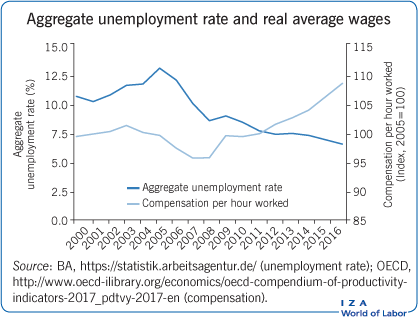
Key findings
Pros
Unemployment is generally low, but especially youth unemployment is very low by international comparison, which appears related to the dual apprenticeship system.
While participation rates have been basically increasing since the mid-2000s across the board, the increase was particularly strong among older workers.
Considering aggregate figures, Germany’s labor market has hardly been affected by the Great Recession—especially not in terms of aggregate employment.
The labor market remains rather rigid by international comparison, but the country manages to avoid many negative side effects that are typically associated with rigidity.
Cons
The trend toward favoring academic education over vocational training threatens the important role of the dual apprenticeship system.
Given comparatively high labor costs in Germany, it is important that the country remains productive and innovative.
The return of protectionism is a threat to the German model, which continues to rely to a substantial extent on exports and imports.
The reduction of unemployment during the last decade is mostly driven by demographic factors in east Germany. The unemployed do not proportionally benefit from the increase in employment.
Demographic change jeopardizes the sustainability of the country’s success, especially when taking structural disadvantages in immigration policy into account.
Author's main message
The German labor market is in good shape: unemployment is low, participation rates are high, and wages are increasing moderately. The labor market has also been remarkably robust to policy experiments, such as the introduction of a statutory minimum wage, and to demand side shocks, such as the Great Recession. However, future risks are on the European and global level, including issues such as Brexit, the stability of the EU and the Eurozone, and the return of protectionism. Additionally, the country appears relatively unprepared for the likely impacts of demographic and technological change.
Motivation
Germany is the EU’s largest economy. As such, the country’s development from the “sick man of Europe” in the early 2000s to an “economic superstar” has received global attention [1]. The country not only successfully managed to escape the unemployment trap it was caught in for decades, but it also performed exceptionally well during and after the Great Recession. It is therefore even argued that Germany could be a reference model for other countries with labor market turmoil. However, it appears at least difficult, if not impossible, to effectively replicate the German model [2]. This article focuses on important developments in the German labor market during the period from 2000 to 2016. The successful transformation of a notoriously rigid labor market into a role model of its own style, combining institutions that typically characterize rigid labor markets with flexibility instruments, took place in exactly this period.
Discussion of pros and cons
For many years, the key challenge for Germany was to reduce high and persistent unemployment. Overcoming this problem was crucial for the “sick man” of Europe. Although the phenomenon of successive, recession-related waves of increasing unemployment was viewed as a European problem in general, Germany served as the prime example for the pattern of high and rising unemployment among the countries in Europe.
The continuous rise in unemployment until the mid-2000s can clearly be seen in Figure 1. Germany’s high unemployment rate has often been linked to high levels of employment protection, high labor costs, and strict regulation of labor markets. As a result, aggregate unemployment figures peaked in 2005. During that year, almost five million workers were on average unemployed in Germany. Since then, this number has nearly been halved to fewer than 2.7 million unemployed persons, as shown in the box highlighting the more recent period.
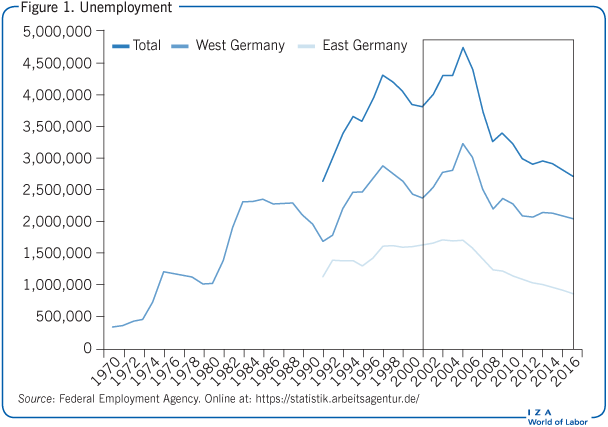
Labor market reforms and beyond: Combining flexibility and rigidity
How did Germany manage this U-turn in the labor market? The short answer is that it has found a way to balance institutions that typically characterize rigid labor markets with flexibility instruments.
In this context, the labor market reforms (“Hartz reforms”) certainly play an important role. Introduced between 2003 and 2005, they mainly comprised the following changes [2], [3], [4]: With the reforms, employment services and related activities became fundamentally restructured, flexible forms of employment such as fixed-term contracts, temporary agency work, and marginal employment were made more attractive, unemployment benefit duration for the elderly was lowered, and all welfare recipients considered able to work were included in activation schemes. A key element was the abolition of means-tested unemployment assistance, an intermediate form of unemployment compensation, which in principle could be received without a time limit until retirement age. Item-wise approved welfare payments were replaced by a monthly lump-sum. In total, these changes led to a significant reduction of long-term unemployment benefits and stricter monitoring activities for the unemployed.
As a result, the labor market reforms successfully addressed the German labor supply problem as, among other things, incentives for job search were improved, ineffective policy instruments such as job creation schemes were abolished, and the requirements for the unemployed to prove ongoing job search efforts were enforced [2]. These changes improved the functioning of the German labor market with an increased effectiveness of active labor market policy and, most importantly, lower reservation wages of the unemployed [4]. Hence, an accelerated matching between unemployed workers and job vacancies was observed.
However, a closer inspection also indicates that the returns to the reforms occurred mainly during the first three to four years afterwards, at least with regard to the reduction of unemployment. Although overall unemployment has continued to decrease by half a million since 2008, this decline is almost entirely due to a decline of unemployment in east Germany. In west Germany, however, the reduction of unemployment has been stagnating since then. The decline of unemployment in east Germany is largely driven by demographic reasons and has little to do with the reforms. The generation who lost their jobs in east Germany during the economic transition after the fall of the Berlin Wall is gradually entering retirement age. One should note that the employment rate in the former German Democratic Republic was above 90%. During the economic transition, it rapidly adjusted to the west German level, leaving behind a substantial number of redundant workers who ended up as long-term unemployed. In the absence of the demographic effect, the German labor market would look less rosy than it actually does. The unemployed are obviously not proportionally benefiting from the remarkable increase in employment that occurred during the same period.
Beyond that, additional elements that have developed more gradually should also be viewed as necessary answers to labor market rigidities in Germany. One example is the country’s vocational education and training system. Figure 2 shows that, although following a similar pattern, youth unemployment rates have been constantly lower than adult unemployment rates during the entire period from 2000 to 2016. This is quite exceptional in the European context [5].
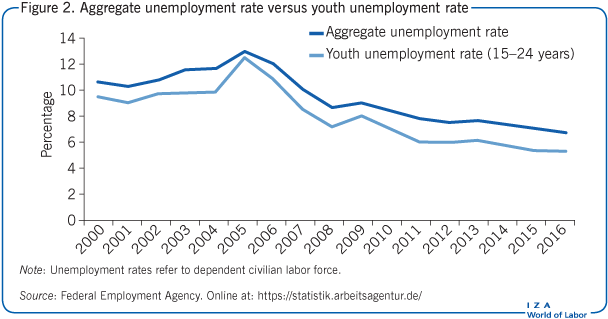
The role of the dual apprenticeship system cannot be overrated in achieving this outcome. In addition to being an effective mechanism to provide skills and qualifications in demand, it also acts as a much-needed counterbalance to hiring barriers in school-to-work transitions. Offering an apprenticeship position is associated with non-negligible costs, but employers receive in return a very reliable and authentic signal about a worker’s productivity—at his or her future workplace—during this period of usually three years. This signal is moreover very valuable and credible for other employers who can rely on these standardized certificates and qualifications. Having such an effective screening device for young workers in place is particularly important in the German context where employment protection legislation is rather strict. Employers would otherwise be very reluctant to hire young workers without having learned about their productivity in advance (or at least having obtained a credible signal). Except for a short probationary period, they cannot simply hire and fire workers to test their actual productivity. For precisely this reason a dual apprenticeship system would have a completely different function in other countries, including for example the US and UK, where employment protection legislation is less strict.
The trend toward favoring academic education over vocational training can also be observed in Germany. While the share of academic among all training in Germany is still below the average share in OECD countries (42% in 2015), it has been steadily rising in recent cohorts, from slightly more than 20% around 2000 to nearly 30% in 2015. This development threatens the important role and function of the dual apprenticeship system. Contrary to the dual apprenticeship system, the academic training system is largely supply-driven, which bears the danger of producing an increasing mismatch between skill supply and skill demand. The phenomenon of overeducation exists in many countries, but not yet in Germany.
Another example of how Germany effectively balances institutions that typically characterize rigid labor markets with flexibility instruments relates to substantial increases in participation rates, especially among older workers. This is perhaps the greatest achievement in the German labor market during the period from 2000 to 2016: An increasing proportion of the working-age population has (re-)entered the labor force. Figure 3 shows that while the increase in participation rates has occurred across the board, it has been more pronounced among particular groups. For example, the participation rate of female workers increased by roughly 10 percentage points and that of low-skilled workers by about 5 percentage points during the same period. Most strikingly, the participation rate of older workers (aged between 55 and 64 years) increased from merely 43% in 2000 to more than 71% in 2016, a nearly 30 percentage point rise in just a decade and a half. This was mainly triggered by the labor market reforms, which effectively reduced monetary incentives for early retirement. It is worth noting that the increase in participation rates among older workers was not at the cost of decreasing activity or unemployment rates among younger workers [6].
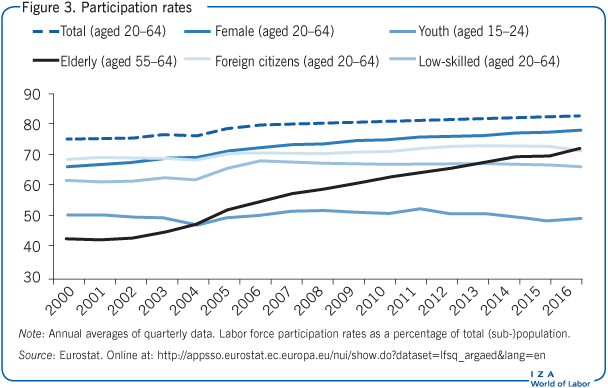
It should also be noted that the abolition of early retirement options took away an important flexibility channel for firms. Before the reforms, firms used early retirement (at least partly financed indirectly via the unemployment insurance system) as a means to circumvent strict employment protection legislation for older workers [4]. But when these options were abolished in the mid-2000s, and the bridge into early retirement was essentially broken, firms (as well as workers who typically used to be more than happy to retire early) were not only theoretically, but now also practically confronted with strict employment protection legislation. It was therefore essential that at the same time the possibilities for using alternative flexibility instruments such as temporary agency work, fixed-term contracts, and marginal employment were available. Without balancing the ending of socially costly early retirement schemes by enforcing other and much cheaper flexibility instruments, the reforms might have easily led to an economic disaster.
Importantly, these flexible forms of employment were mostly created in addition to permanent full-time jobs that are subject to social security contributions. Hence, the share of people in the working-age population holding a job that may be labeled as “standard employment” has not only been fairly stable at around 40% since the early 2000s [7], it even increased in absolute terms. Simultaneously, the inactive population has markedly declined over the last 20 years, since there has been an increase in the share of people holding other flexible jobs. For example, the share of temporary agency work did increase, but it has stabilized at around 2% of all employed persons in recent years—which is roughly the same fraction as in the US, France, or Japan [8].
Competitiveness, inequality, and the Great Recession
Germany improved its international competitiveness as the percentage changes to unit labor costs in Figure 4 show. Especially in the early 2000s, growth rates of this measure were comparatively small in Germany—and in many years even negative. This is in stark contrast to the development in other countries such as the US, the UK, France, or Italy, where unit labor costs increased, often at rapid rates, during this period (except for the US in 2002). In recent years, however, the development of unit labor costs in Germany has been comparable to that in other economies (in terms of percentage changes). Finally, it should be noted that the comparatively strong increase in unit labor costs in 2009 is related to Germany’s unique and specific reaction to the Great Recession (i.e. employment adjustments mainly at the intensive margin, see details below).
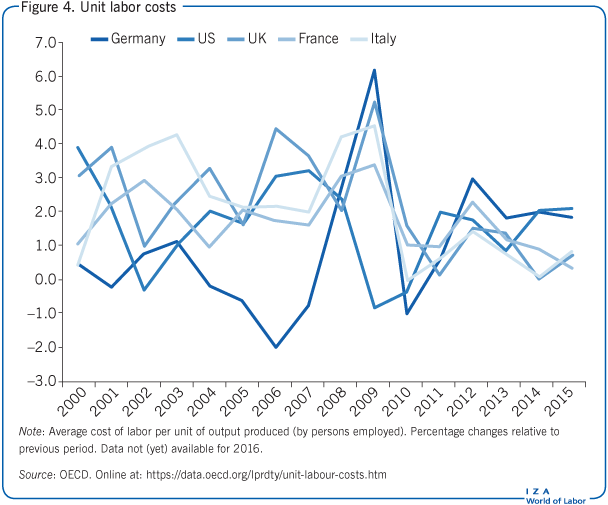
An important factor in this context is wage restraint. Union wages increased only moderately, but, equally important, unions and employers increasingly used the collective bargaining process to arrive at more flexible labor arrangements [2]. This was, for example, possible via so-called opening clauses in the contracts between unions and employers’ associations that are valid at times of crisis. Such clauses became increasingly common and are associated with greater wage dispersion and higher employment growth. The more flexible labor arrangements allowed the adjustment, restructuring, and reorganizing of existing work processes not only at the industry or sector level, but also at the firm level.
This (localized) flexibility is also a very important factor in explaining Germany’s resilience to the Great Recession, which hit the country mainly through declining exports. It thus arrived as a transitory external demand shock, which is different from what many other economies experienced [2]. Figure 5 shows that decline in output was nonetheless large—GDP decreased by 4.7% in 2009 relative to the previous year. Surprisingly, while working hours declined by a similar magnitude, total employment remained relatively constant. This phenomenon has been referred to as “internal flexibility” and it represents a core strength of Germany’s labor market in recent years, contributing to its resilience to the Great Recession [9].
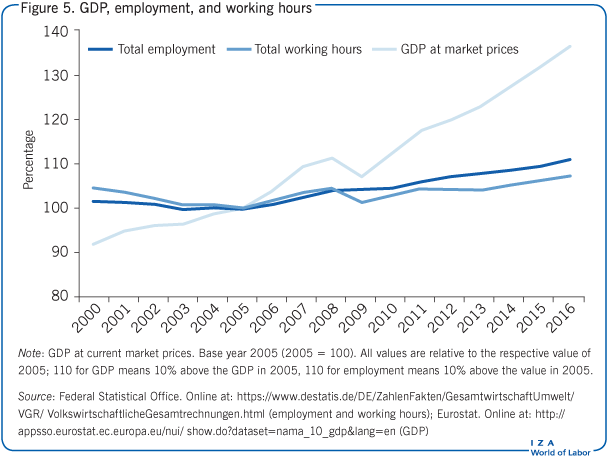
Although the weight attached to each factor may differ, the following aspects are generally considered as being highly relevant in this context: (i) the specific nature of the economic shock that hit Germany, (ii) the concrete policy responses during the critical period (mainly the expansion of short-time work), (iii) the significant reforms that had improved the functioning and resistance of the country’s labor market, and (iv) long-term demographic trends which are expected to result in shortages of skilled labor. Ultimately, it is likely that the combination of these factors resulted in adjustments of hours per worker rather than the number of workers [2]. Firms also followed this strategy of internal flexibility because employment did not expand during the previous boom [9], and they largely viewed the shock as only temporary and anticipated a rather quick recovery (which then actually happened, as documented by the development of GDP in Figure 5). For precisely these reasons, Germany was able to preserve its productive capacities during the Great Recession, so that they were immediately usable when demand increased again. The country still reaps the benefits from its advantageous starting position after the crisis.
The gain in competitiveness has been accompanied by rising wage inequality. As has been the case in many countries, wage inequality has widened substantially in Germany over the past two decades [10]. For example, from 1996 to 2009 the gap between the 20th and 80th percentile of the wage distribution widened by approximately 20 log points, which is roughly comparable to the corresponding rise in the US during the 1980s [11]. Figure 6 shows that the trend toward growing earnings and income inequality can also be observed during the period from 2009 to 2016, including the standard comparison of the 10th and 90th percentiles, albeit more moderately.
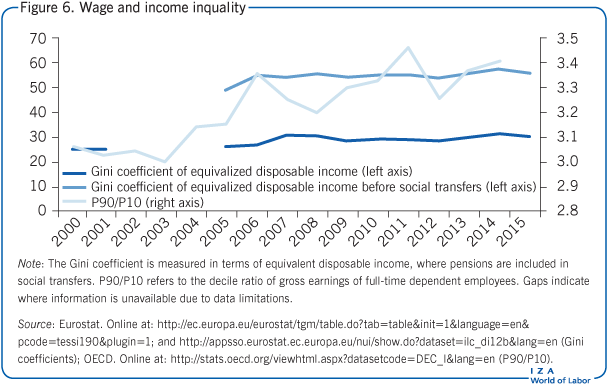
There are several explanations of this increasing inequality. For example, the way workers sort to workplaces may have fundamentally changed, as documented by an increasing tendency for very productive workers to sort to establishments offering larger wage premiums [11]. This may also be linked to the relative fall in collective bargaining coverage among these firms. Increasing wage inequality in Germany is thus related to changes in employment behavior, even though a large part of this increase is compensated by payments made by the welfare state [12].
Demographic change, immigration policy, and technological change
In the future Germany will increasingly have to deal with the impacts of demographic change. The country’s population and labor force are projected to age and decline. According to recent projections by the Federal Statistical Office, the working-age population will shrink tremendously. Between 2020 and 2060, the number of people aged 20 to 64 years is expected to decline by up to 15 million, or 30% [13]. Recent developments such as increasing participation rates or higher immigration rates will have relatively small impacts on these numbers, as in the longer term the number of deaths will increasingly exceed the number of births in Germany.
The impacts of demographic change will be heterogeneous across regions, with regions that already face structural problems presumably becoming more strongly affected. Furthermore, the declining and aging population jeopardizes the innovative potential of Germany as a whole, which is all the more important in a high-wage country that relies on a productive and innovative workforce. It also threatens the sustainability of the country’s social security system, as the baby boom generation reaches the retirement age within the next 20 years.
Germany’s current immigration policy is unable to cushion the impacts of demographic change in the long term. Figure 7 shows that net immigration has increased substantially in recent years. These numbers put Germany on a level playing field with other major immigrant-receiving countries, such as the US and Canada. Predominantly, humanitarian migrants and citizens from other countries of the EU have moved to Germany. What is needed in addition is a focus on economic migrants from countries outside the EU, who currently only account for a tiny fraction of all migrants. Right now, the relatively large numbers of migrants from other countries of the EU, who enjoy freedom of movement and yet arrive predominantly for employment reasons, conceal the long-term need for this form of migration from non-EU countries. But this will eventually change, as the entire EU will be confronted with shrinking and aging populations. Admittedly, Germany has to deal with structural disadvantages in its immigration policy, such as the language barrier, but there are additional legal and institutional barriers that could be eliminated.
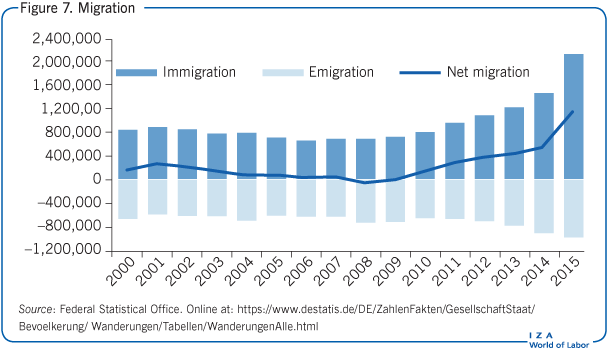
Ongoing technological change, currently often referred to as “digitalization,” will have potentially large impacts on global, national, and regional labor markets. But at least so far, this form of technological change appears to have had no disruptive impacts on the German labor market [7]. While it is true that continuous structural changes can be observed, it is hard to establish causal links to digitalization.
Nevertheless, Germany seems relatively unprepared for technological change. The country has two Achilles’ heels in this context, whose consequences will be very likely aggravated in the digital era: The first one relates to the marketing of innovations, which is rather weak, and the second to the start-up scene, which is still not well established. Additionally, through new emerging forms of employment that are not covered by standard institutions, digitalization also threatens the sustainability of the social security system, which is already under pressure from demographic change.
Limitations and gaps
A consensus about the effects of the statutory minimum wage in Germany, which was introduced in 2015, has not yet emerged. Before its introduction, many economists had estimated very large negative employment effects, but the initial evidence is actually at odds with these figures. A rigorous and broad evaluation of the effects is currently under way.
In addition, while aggregate unemployment has been continuously decreasing in recent years and the German labor market is generally in a very good shape, the country’s long-term unemployment rate exceeds the OECD average. The reasons why the number of long-term unemployed has stagnated for several years have yet to be determined.
Summary and policy advice
The German labor market is still rather rigid, but many negative side effects that are typically associated with such rigidity have not materialized due to accompanying instruments that enhanced flexibility. These changes characterize a very successful “German model,” balancing rigidity and flexibility in a symbiotic manner, one which may be hard to replicate in other countries. But while the German labor market is currently in excellent shape, this certainly does not imply that this situation will last forever. It also does not imply that flexibility could be constrained without cost. The costs associated with policies limiting the current amount of flexibility could be huge, and could even lead back to the path of the sick man of Europe.
Long-term developments such as demographic change and digitalization require forward-looking reforms. One specific area for policy action is immigration policy, in which a system focusing on economic needs and the labor market should be encouraged. Another area where reforms will become inevitable is the social security system. A declining and aging population as well as more flexible forms of employment require new answers from social policy. Finally, an improvement to the academic system could be made by having universities provide information on the employment prospects and career paths of their graduates, allowing college entrants to make informed decisions and avoid obtaining useless qualifications. This would at least partly complement the largely supply-driven portfolio of occupational training with demand-oriented elements and thus help to avoid moving toward overeducation and mismatch.
Acknowledgments
The authors thank the IZA World of Labor editors for helpful comments, and Patrizia Massner for her excellent research assistance.
Competing interests
The IZA World of Labor project is committed to the IZA Guiding Principles of Research Integrity. The author declares to have observed these principles.
© Ulf Rinne and Hilmar Schneider